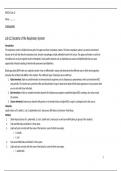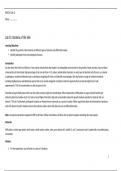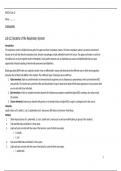Bios 242 week 6 lab - Study guides, Class notes & Summaries
Looking for the best study guides, study notes and summaries about Bios 242 week 6 lab? On this page you'll find 39 study documents about Bios 242 week 6 lab.
All 39 results
Sort by

-
BIOS 242 Week 6 Lab 2 Bacteria of Respiratory System Chamberlain
- Other • 4 pages • 2023
- Available in package deal
-
- $14.99
- 1x sold
- + learn more
Lab12:BacteriaoftheRespiratorySystem Introduction: Therespiratorysystemisdividedintotwoparts:theupperandlowerrespiratorysystems.Thelowerrespiratorysystemisanaxenicenvironmentbecauseof the cilia that lines the respiratory tract, alveolar macrophages and IgA antibodies found in the mucus. The upper part harbors a variety of microbiotasuch as Gram-negative bacteria Hemophilus, Gram-positive bacteria such as Staphylococcus aureus and diphtheroids that can cause opportunisticinfectionsleading toinf...

-
BIOS 242 Week 6 Lab 1 Bacteria of the skin Chamberlain
- Other • 6 pages • 2023
- Available in package deal
-
- $14.99
- + learn more
Lab11:BacteriaoftheSkin LearningObjectives: • Identifythegrowthofskinbacteriaondifferenttypesofselectiveanddifferentialmedia. • Identifypathogenicfromnon-pathogenicbacteria Introduction: Our skin forms the first line of defense. It has several characteristics that makes it an inhospitable environment for the growth of most microbes. Some of thesecharacteristics of skin include: high percentage of salt, low pH from 4-5.5, sebum, antimicrobial chemicals; an outer layer of dead skin cell...

-
BIOS 242 Week 6 Lab 1; Bacteria of the skin
- Other • 6 pages • 2023
- Available in package deal
-
- $23.48
- + learn more
Lab11:BacteriaoftheSkin LearningObjectives: • Identifythegrowthofskinbacteriaondifferenttypesofselectiveanddifferentialmedia. • Identifypathogenicfromnon-pathogenicbacteria Introduction: Our skin forms the first line of defense. It has several characteristics that makes it an inhospitable environment for the growth of most microbes. Some of thesecharacteristics of skin include: high percentage of salt, low pH from 4-5.5, sebum, antimicrobial chemicals; an outer layer of dead skin cell...

-
BIOS 242 Week 6 Lab 1; Bacteria of the skin
- Other • 6 pages • 2023
- Available in package deal
-
- $21.48
- + learn more
Lab11:BacteriaoftheSkin LearningObjectives: • Identifythegrowthofskinbacteriaondifferenttypesofselectiveanddifferentialmedia. • Identifypathogenicfromnon-pathogenicbacteria Introduction: Our skin forms the first line of defense. It has several characteristics that makes it an inhospitable environment for the growth of most microbes. Some of thesecharacteristics of skin include: high percentage of salt, low pH from 4-5.5, sebum, antimicrobial chemicals; an outer layer of dead skin cell...
BIOS 242 Week 6 Lab 2; Bacteria of Respiratory System

-
BIOS 242 Week 6 Lab 2; Bacteria of Respiratory System
- Other • 4 pages • 2023
- Available in package deal
-
- $23.48
- + learn more
Lab12:BacteriaoftheRespiratorySystem Introduction: Therespiratorysystemisdividedintotwoparts:theupperandlowerrespiratorysystems.Thelowerrespiratorysystemisanaxenicenvironmentbecauseof the cilia that lines the respiratory tract, alveolar macrophages and IgA antibodies found in the mucus. The upper part harbors a variety of microbiotasuch as Gram-negative bacteria Hemophilus, Gram-positive bacteria such as Staphylococcus aureus and diphtheroids that can cause opportunisticinfectionsleading toinf...

-
BIOS 242 Week 6 Lab 2; Bacteria of Respiratory System
- Other • 4 pages • 2023
- Available in package deal
-
- $23.48
- + learn more
Lab12:BacteriaoftheRespiratorySystem Introduction: Therespiratorysystemisdividedintotwoparts:theupperandlowerrespiratorysystems.Thelowerrespiratorysystemisanaxenicenvironmentbecauseof the cilia that lines the respiratory tract, alveolar macrophages and IgA antibodies found in the mucus. The upper part harbors a variety of microbiotasuch as Gram-negative bacteria Hemophilus, Gram-positive bacteria such as Staphylococcus aureus and diphtheroids that can cause opportunisticinfectionsleading toinf...

-
BIOS 242 Week 6 Lab 2; Bacteria of Respiratory System
- Other • 4 pages • 2023
- Available in package deal
-
- $21.48
- + learn more
Lab12:BacteriaoftheRespiratorySystem Introduction: Therespiratorysystemisdividedintotwoparts:theupperandlowerrespiratorysystems.Thelowerrespiratorysystemisanaxenicenvironmentbecauseof the cilia that lines the respiratory tract, alveolar macrophages and IgA antibodies found in the mucus. The upper part harbors a variety of microbiotasuch as Gram-negative bacteria Hemophilus, Gram-positive bacteria such as Staphylococcus aureus and diphtheroids that can cause opportunisticinfectionsleading toinf...

-
BIOS 242 Week 6 Lab 1; Bacteria of the skin
- Other • 6 pages • 2023
- Available in package deal
-
- $25.49
- + learn more
Lab 11: Bacteria of the Skin Learning Objectives: • Identify the growth of skin bacteria on different types of selective and differential media. • Identify pathogenic from non-pathogenic bacteria Introduction: Our skin forms the first line of defense. It has several characteristics that makes it an inhospitable environment for the growth of most microbes. Some of these characteristics of skin include: high percentage of salt, low pH from 4-5.5, sebum, antimicrobial chemicals; an outer...

-
BIOS 242 Week 6 Lab 2; Bacteria of Respiratory System
- Other • 4 pages • 2023
- Available in package deal
-
- $20.49
- + learn more
Lab 12: Bacteria of the Respiratory System Introduction: The respiratory system is divided into two parts: the upper and lower respiratory systems. The lower respiratory system is an axenic environment because of the cilia that lines the respiratory tract, alveolar macrophages and IgA antibodies found in the mucus. The upper part harbors a variety of microbiota such as Gram-negative bacteria Hemophilus, Gram-positive bacteria such as Staphylococcus aureus and diphtheroids that can cause opport...

How did he do that? By selling his study resources on Stuvia. Try it yourself! Discover all about earning on Stuvia



